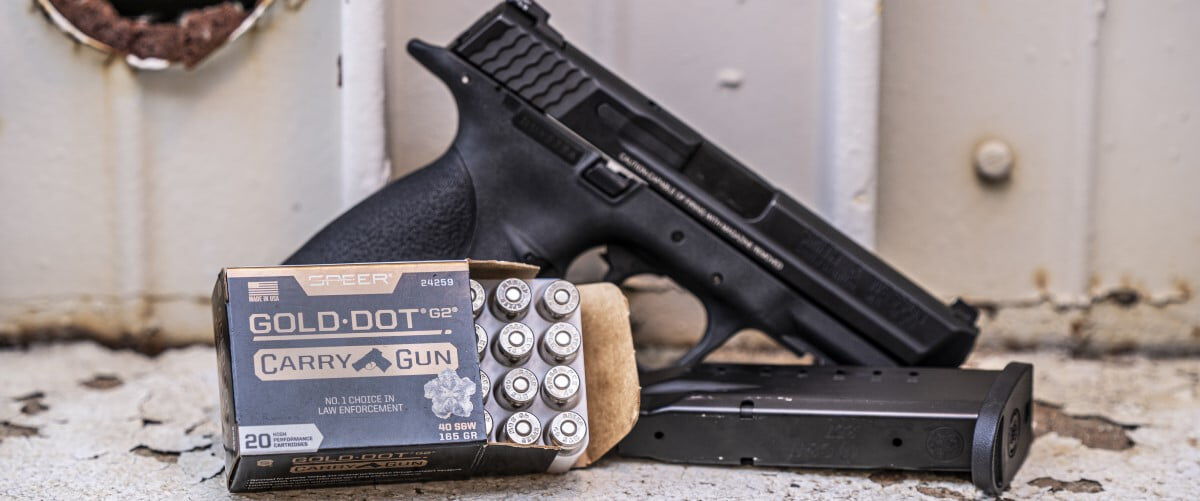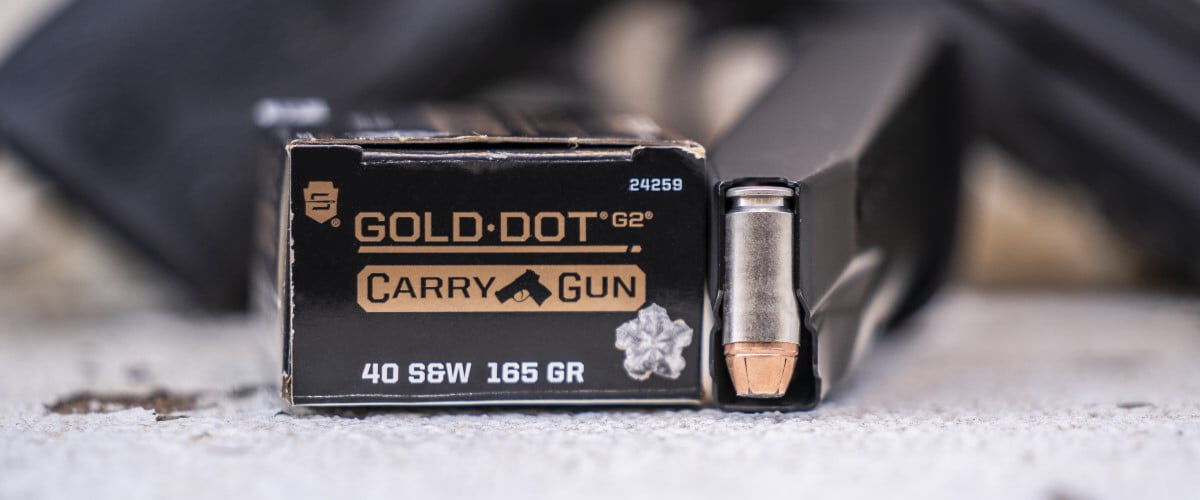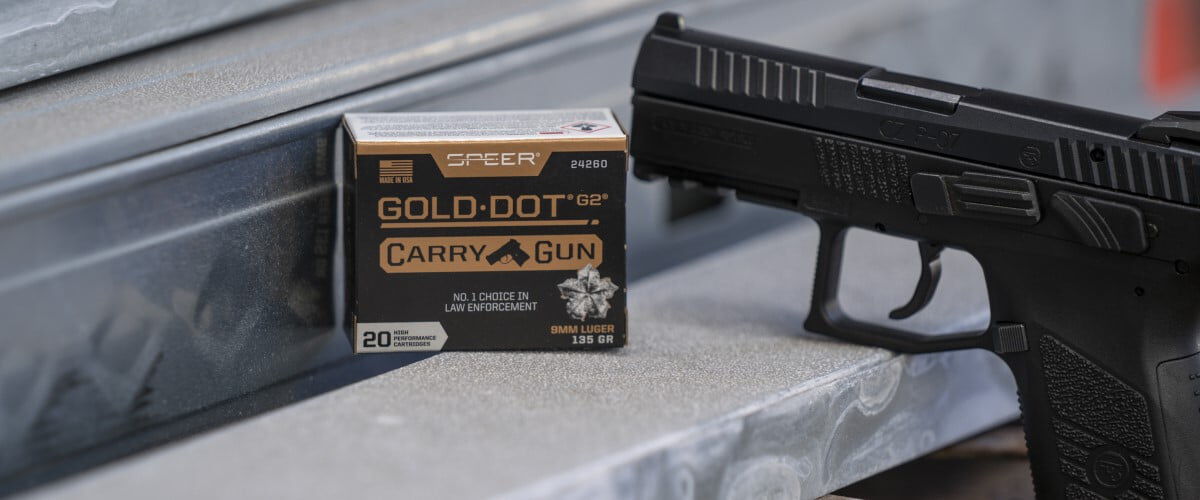
It’s been a long road. After the so-called Miami shootout in 1989, a deadly encounter during which law enforcement rounds infamously failed to adequately neutralize attackers, ammunition manufacturers completely changed how they design, build and test defensive bullets. Speer Gold Dot emerged in the wake of the tragic event, and it’s been the leading choice of law enforcement professionals ever since.
The evolution didn’t stop there. In the decades since, Speer engineers have built off the original Gold Dot platform time and again, and today those who carry a concealed compact handgun have a better option than ever before: Gold Dot Carry Gun.
But like most good things, it didn’t happen overnight. Let’s dive into the incredible origin story of the ultimate defensive round and learn what truly sets it apart.
The Gold Dot Story
After the debacle in Miami, the FBI set out to develop a method by which to evaluate bullet performance and ensure duty ammunition offered sufficient energy, expansion and penetration capabilities. The resulting series of tests became known as the FBI protocol.
When Speer introduced Gold Dot in 1991, it was a revolutionary step forward in bullet design. Until that point, duty bullets were made of a lead core with a drawn jacket and hollow point nose cavity to initiate expansion. Speer opted to use a different technique, fusing a pressure-formed lead core to a plated jacket. This design created a molecular bond between the jacket and core and virtually eliminated any risk of bullet separation. In doing this, Speer not only set a new standard in duty bullet performance but also ushered in the age of bonded bullets. The process is called Uni-Cor construction.
The bonded design also helps Gold Dot bullets retain weight and transfer energy effectively, even when fired through barriers—one of the factors that made them perform well in FBI protocol tests for decades. The Uni-Cor design not only allows Gold Dot bullets to expand and create massive wound channels but also penetrate very well through a variety of barriers. What’s more, plating the copper onto the lead core provides precise control over jacket thickness, ensuring better accuracy and allowing Speer engineers the flexibility to customize jacket thickness for each individual load.
A New Generation
Gold Dot G2 is a recent evolution from original Gold Dot aimed at achieving even better FBI-protocol test scores than its predecessor. Both the standard Gold Dot and Gold Dot G2 bullets utilize Uni-Cor construction, but the G2’s unique design is an evolutionary step forward in duty bullet protocol performance. Rather than the traditional hollow point design of the Gold Dot, the G2 features a shallow cavity in the nose filled with durable elastomer. This prevents barrier materials from filling the nose cavity and inhibiting expansion. It provides more consistent performance through tough barriers like wood and steel.
“Gold Dot is a more traditional hollow point design,” says Speer Product Manager Chris Laack. G2 is a different style of bullet, and its combination of a shallow nose cavity, new skiving, and an elastomer-filled nose cavity allow it to excel in the most difficult barrier tests.
“What G2 does is keep things like plywood from filling the hollow cavity and preventing other tissue from entering and causing it to open,” Laack says. “It just prevents that hollow point from getting plugged. It’s important on some of those harder barriers like plywood or steel where steel can kind of deform the nose of the bullet and collapse the hollow point in on itself. Our G2 design prevents that.”

Fissures cut into the bullet cause the G2 to expand reliably and transfer energy effectively while maintaining straight-line penetration, and that’s what has allowed Gold Dot G2 to achieve the highest FBI protocol evaluation scores of any ammunition ever tested.
“The proprietary elastomer helps ensure proper expansion through barriers,” says Laack. “Simply put, we evolved Gold Dot G2 to work even better through barriers than the original proven Gold Dot.”
Optimized For Compact Carry
If Gold Dot G2 had a downside, it’s that its pedigree as duty round means it is designed to perform in full-sized handguns. However, many self-defenders who carry concealed prefer more discreet handguns with shorter barrels. To meet those preferences, Speer created Gold Dot Carry Gun.
“Gold Dot Carry Gun takes the idea of the G2 duty bullet and applies it to everyday carry-type firearms.” Laack says. “We took the G2 design and that purpose of working through all those barriers and applied it to compact handguns.”
To accomplish this, Speer engineers developed lighter, modified Gold Dot G2 style bullets that would reach optimum velocities in short-barreled pistols. With Gold Dot Carry Gun you can expect the same performance that made the Gold Dot and Gold Dot G2 famous—reliable expansion and exceptional barrier penetration—from lighter, smaller carry pistols.
“We said to ourselves: If we are going to make a bullet as barrier-blind as possible with excellent terminal performance, could we make it work with the more limited velocity potential in a short barrel?” Laack says. “The answer was yes. To do this, each of the bullets in Carry Gun are completely redesigned versions of G2. They are slightly lighter than their G2 counterparts, which means we can get a little more velocity out of them. We also redesigned the shallow cavity and did several other modifications to optimize it for common carry guns.”

The Gold Dot Carry Gun design also allowed Speer engineers to fine-tune these loads—each specific caliber individually—for outstanding performance out of short barrels. The Gold Dot Carry Gun 9mm Luger utilizes a 135-grain bullet instead of the 147-grain bullet in the Gold Dot G2 ammunition. The 40 S&W Gold Dot Carry Gun fires a 165-grain bullet as opposed to the 180-grain offering from the G2 load. Finally, the 45 Auto +P Carry Gun bullet weighs in at 200 grains instead of the 230-grain G2.
Gold Dot G2 has already proven to be a top performer FBI test protocol for duty bullets, and Laack says Gold Dot Carry Gun is capable of that same class-leading performance from compact and subcompact handguns.
A New Breed Of Defense Bullet
“Gold Dot Carry Gun is going to be the highest-scoring protocol round out of a compact gun ever,” he says. “We are seeing really great results shooting it through FBI protocol.”
Most shooters believe a defensive bullet—any defensive bullet—will perform well in typical self-defense situations. But a duty bullet that is designed for and optimized to a full-sized duty pistol might not perform to the same standard from a short-barreled carry or backup gun. By taking the Gold Dot G2 bullet and customizing it to function in short-barreled defense pistols Speer has created a self-defense load truly optimized for the guns in which it will be carried.
Speer Gold Dot Carry Gun offers not only the best bullet for self-defense but adds features that ensure this ammunition will perform reliably under any conditions. That begins with the use of quality nickel-plated cases that feed reliably. That’s coupled with advanced powders that perform consistently, and a sealed CCI primer that’s sensitive and reliable.
There’s no room for compromise in a self-defense situation. When lives are on the line you must rely on your self-defense ammo to perform flawlessly, and Speer’s Gold Dot Carry Gun does just that.